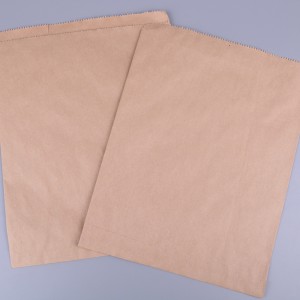Celebrating its fiftieth anniversary, the 1973 Bloomingdale’s Big Brown Bag was hailed by The New York Times and PRINT’s Jessica Deseo as a landmark of progressive marketing. What set it apart from other shopping bags was the inspired absence of any store identity or logo whatsoever; an audacious idea, a revolution in retail.
An equally innovative and surprising cousin of the Big Brown Bag, was the long running series of variously styled artists’ shopping bags orchestrated by John Jay (who from 1979 as Senior Art Director of Men’s and Home Furnishings moved to Creative Director of all the company’s advertising and design during the eighties and early nineties), created by an impressive roster of designers, artists, illustrators and architects from all over the world. Among them were Michael Graves, Anthony Russo, Susan Curtis, Mark Kostabi, Ettore Sottsass; Gene Greif and Neville Brody. Die Cut Handle Kraft Paper Bag

Currently, Jay is the President of Global Creative for Fast Retailing Inc., the parent company of international fashion brands – including Uniqlo, for whom he has launched major marketing programs also with artists and designers. I was recently asked to write an essay for a monograph soon to be published by Rizzoli. During the current celebration for the iconic Big Brown Bag, it is important to recall that Jay’s work at Bloomies helped establish an enviable reputation for the store and beyond. The following is adapted from the essay for Jay’s book.
Jay’s bags also lacked the store name or logo. Unlike the recognizable consistency of Big Brown Bag, Jay commissioned unique artists’ bags three to four times a year, depending on what seasonal marketing events demanded. Holidays were frequent themes, a New Year’s bag, a summer bag, fall “concept” bags and other cultural treats.
“I used the bags as a demonstration of Bloomingdale’s’ connection to the global creative zeitgeist,” recalls Jay. “Being a true, full line department store and not just fashion gave me the opportunity to speak to movements such as Postmodernism in architecture or Memphis design.”
Jay used these retail opportunities to create bags that represented forms and styles from the edge in other cultures. They were always designed to astound—and morph into a completely different idea from one bag to the next. “I would never have two illustration bags back to back or two photography bags in a row,” he explains. What interested the Ohio-born Jay, the son of Chinese immigrant parents, was using the bag as a “a signal of cultural change” and a prediction of what was certain to be “exciting and influential.”
Even without a logo, the Bloomingdale’s brand was more recognizable than many other comparable names. “As soon as the new one hit the streets of New York, people would recognize it as ours,” Jay rightly crows. “We were consistently ‘inconsistent.’” The Bloomingdale’s attitude, indeed its overall strategy, was devoted to respect for the intelligence of its customers. And it worked. They owned what today would be called the shopping bag space.
Jay was invested in curating a vibrant mix. “The Michael Graves bag came from my interest in Postmodernism and how Michael was really challenging the status quo of modernism.” Jay refers to being inspired by Grave’s Portlandia Building in Portland, OR, “long before I ever knew I would live in the city.” Another big bag, the Bloomingdale’s 1980 China bag, arguably was the most auspicious retail promotion in history—and decidedly the most internationally consequential. It was called “Dawn of a New Age” and based on Richard Nixon and Henry Kissinger’s so-called “ping pong diplomacy” that had helped to open China in 1972. By 1979 The People’s Republic had emerged from its Maoist economic isolation and debuted as a global commerce wellspring. Bloomingdale’s produced the first major advertising and marketing campaign in China. “We opened a competition between an [ad] team in Shanghai vs. Beijing,” Jay recalls. “The Shanghai bag was declared the winner and the team was to receive a new Sony TV. However, when this was communicated to the Chinese, they didn’t understand the competition concept and asked that we award both offices a new TV.”
Jay’s final bag for Bloomingdale’s has “the honor of being the only bag ever pulled from the stores.” As Jay recounts it: “When Studio 54’s Steve Rubell and Ian Shrager got out of prison, one of their big comeback projects was to open The Palladium ballroom by architect Arata Isozaki. The famous Mike Todd room featured trending downtown artists such as Keith Haring and Jean Michel Basquiat. The ‘club girl’ of the moment, manning the door each night, was Sally Randall”. Jay asked her to pick an artist shown in the club to do his next bag (by then the bags were “commenting” on the current scene). “She presented to me the relatively unknown Mark Kostabi, who had a knack for social commentary through his humor and surreal figures. His solution was to poke fun of us at Bloomingdale’s by showing figures with cash registers as heads and the Postmodern Chippendale rooftop of the ATT building by Phillip Johnson and John Burgee. It was a sarcastic jab at money and status. I loved it.”
That Jay’s shopping bags are in many permanent museum collections around the world is a reminder of a period of creative freedom. “For me, they represent an era of intelligence and innovation for all that has disappeared from the retail landscape,” he says, adding, “Yes, Bloomingdale’s still covets the Big Brown Bag by Massimo Vignelli. I still love it as well … but it is no longer a surprise. It is an icon of the ’70s.”
Steven Heller has written for PRINT since the 1980s. He is co-chair of SVA MFA Designer as Entrepreneur. The author, co-author and editor of over 200 books on design and popular culture, Heller is also the recipient of the Smithsonian Institution National Design Award for "Design Mind," the AIGA Medal for Lifetime Achievement and other honors. He was a senior art director at The New York Times for 33 years and a writer of obituaries and book review columnist for the newspaper, as well. His memoir, Growing Up Underground (Princeton Architectural Press) was published in 2022. Some of his recent essays are collected in For the Love of Design (Allworth Press).

Paper Packet Keep up with all things PRINT by subscribing to our weekly email newsletter.